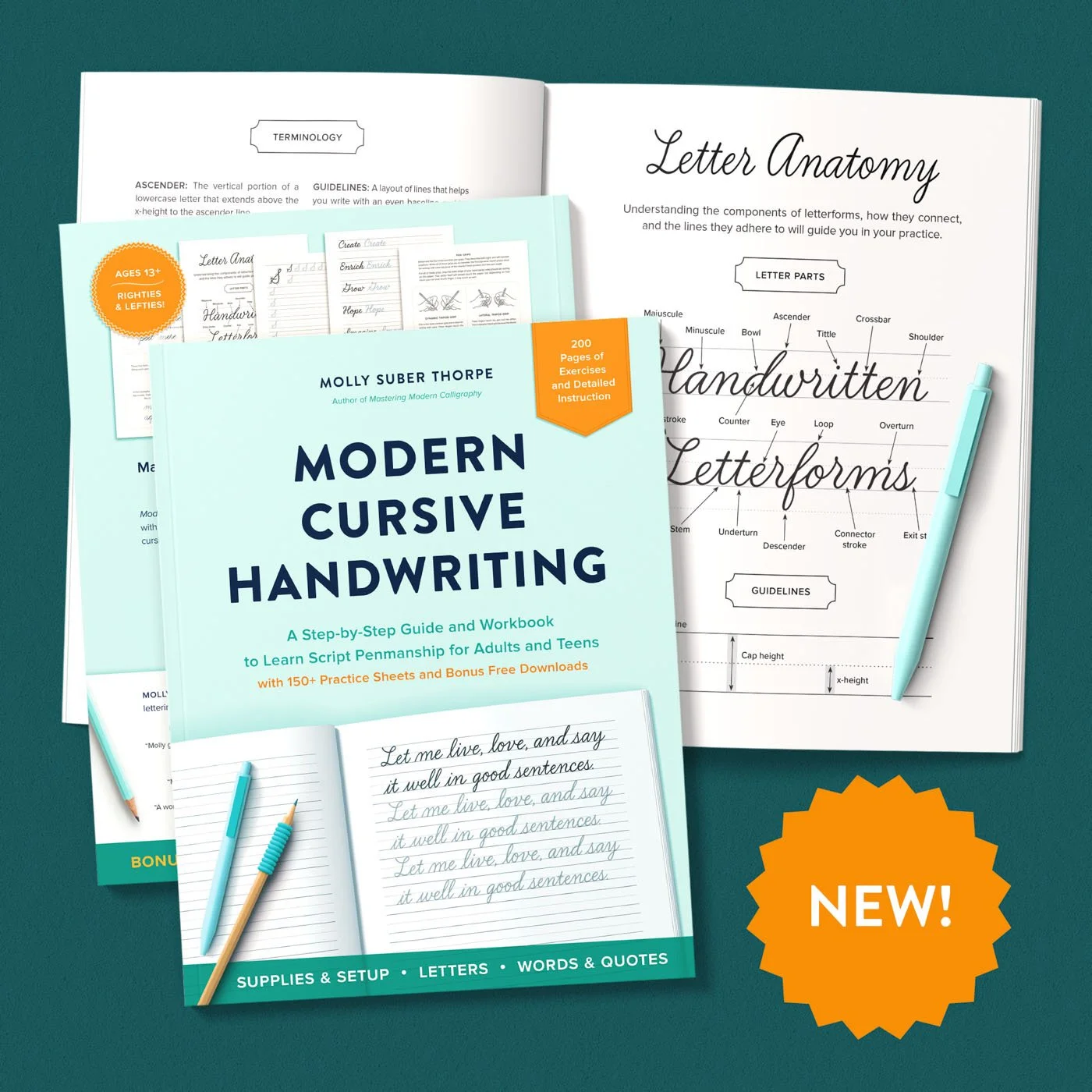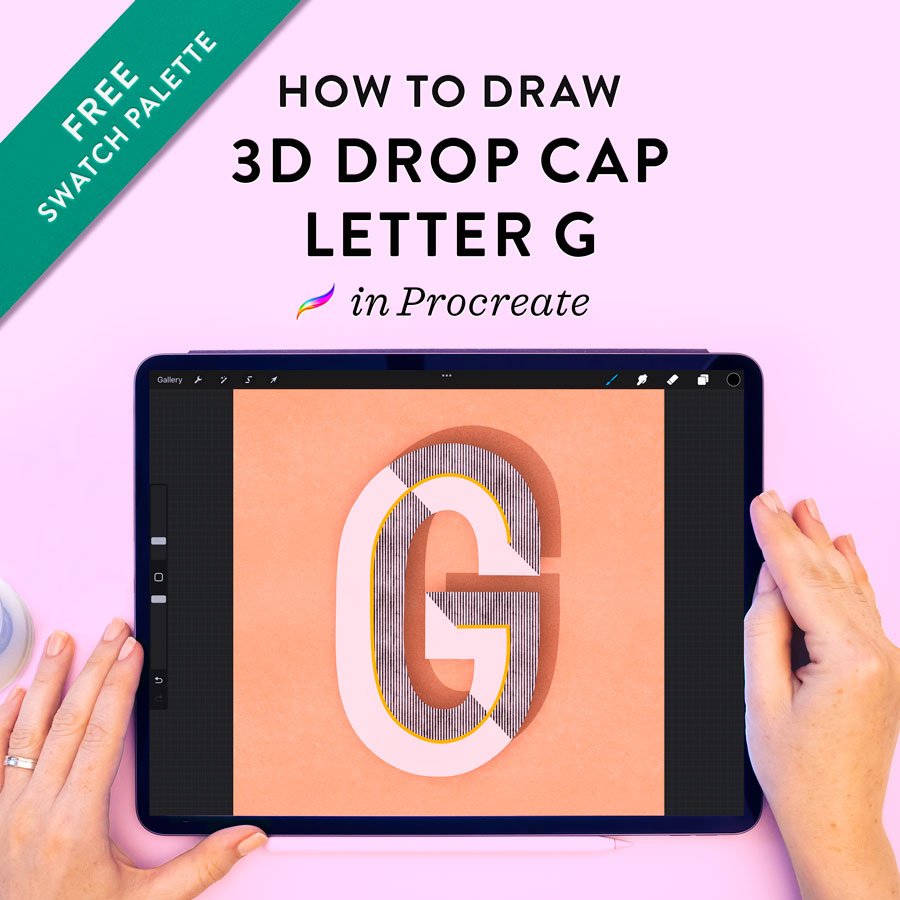Find Your Calligraphy Style: An Exercise to Transform Your Lettering
I earn small commissions for purchases made through links in this post. Proceeds help me to continue producing free content.
Learn my favorite exercise for calligraphers looking to transform their calligraphy style, or add more styles to their repertoire. In this video, I'll walk you through this fun exercise it in real time, and give you detailed commentary and tips as I go.
Watch my video tutorial above or read the written instructions below.
Today’s video is a short tutorial about finding your own calligraphy style, using an exercise that’s helpful to analog and digital calligraphers alike. I will walk you through my absolute favorite methos for modern calligraphers when it comes to creating a unique style, all your own.
This is an exercise that I created for my intermediate and advanced workshop students. I found that it has really helped people break out of habits – even good ones – that they may have, allowing them to create lettering styles that are new and different, which they can offer to clients or use in personal projects
Unlock 2 weeks of unlimited learning for free
I originally published this as a Skillshare class, but I’ve now chosen to share it on my YouTube channel for free! I have a lot of classes on Skillshare, most of them longer and more in-depth than this one. So if you’re interested in checking those out, and getting two weeks of premium Skillshare membership for free, click here to unlock your discount.
This exercise is all about learning how to critique your work productively.
It can be a very dangerous mindset to compare yourself, as an artist, to other artists you see. In fact, it can be quite self-defeating.
Transforming your lettering – either improving it or just changing it into something new and different – requires you to really critique your work in a way that allows you to make targeted changes, rather than just give up and feel deflated.
Ultimately, my goal here is for you to have a lot of fun.
I don't want you to follow along and try to emulate the exact lettering styles that I'm making, because as you're going to see, this is really about making changes to lettering that you already do and, in a step-by-step process, transforming one style you're comfortable with into another new style.
Getting started
I have here just four basic grid lines that I’ve drawn with my transparent ruler. I am not using a calligraphy grid today, because the whole point of this exercise is not to adhere to specific slant lines, x-height lines, cap height lines, etc. In fact, this exercise is really about breaking free of habits and finding new modern calligraphy styles that you might not have found if you had otherwise tried to create them just from trial and error.
So I’m going to get started by writing out a word in a style that I'm most comfortable with. I’m writing it in whatever style comes most naturally to me without thinking too much through it. If you know me, my modern calligraphy style is already quite loose and varied, but I’m just going to stick with the basics now and write out a single word: calligraphy.
The starting point
Here you'll see that I wrote this out with slightly varied distances between the letters, but I kept to the baseline. So there is, among other things, a consistent baseline and a relatively consistent cap height with ascender height.
Height uniformity
What I mean by that is that the top of the C and the tops of the l and h come to basically the same line. Same goes for my descender length – my g, p, and y come essentially down the same length.
On top of that, even though I wasn't adhering to a grid, I did keep my letters at roughly the same italics slant because I can see that the axis of my letters matches.
Let’s look at the x-height
X-height means the distance from the baseline to the top of any lowercase letter which does not have an ascender. Traditionally that’s a lowercase x, but in this case, my a, i, and the top bowl of my g all come to my x-height.
So you can see that in this particular exercise, I also made a pretty consistent x-height. My i’s are roughly the same height. The bowls of the g and the p, as well as the overturn of the h, are all roughly the same height, too.
I would call this a modern style because it doesn’t adhere to a traditional style like Copperplate. It does, however, adhere to a lot of the traditional rules about uniformity.
Change #1: Decrease the x-height
So now I'm going to do one change at a time.
The first change I want to do is decrease the x-height, but I want to keep everything else the same. I'm going to aim to keep the same slant, the same distance between the letters, the same pressure on my pen (so I get the same boldness), and the same uniformity in ascender and descender heights. The only change will be to decrease my x-height.
So let's see what that does to the overall look and feel….
Close but not quite there…
OK, so my attempt at uniformity with the first version was pretty close. I do have a slightly lower x-height now, which did make my word and shorter, because lower x-height means that the letters shrunk a little bit, too.
Decrease the x-height even more!
Let's just get dramatic here! I’m going to make another version where I further decrease the x-height.
It can be hard to write this small with such a thick nib as what I'm using – a Brause EF66 – but you can see how even though the height of my C’s are the same, and my ascenders and descenders all come to the same size, the second version already looks more formal, just because the x-height is lower.
Change #2: Extend the connector strokes
In this one-step-at-a-time exercise, we're always going to take the last version we made – provided that we kind of like it (if you hate that version, you can go back a step) – and continue applying a single change at a time.
So this time I'm going to spread out the letters, which means I’m taking all the connector strokes and I'm going to extend them. I’m going to do it really dramatically so that we can see a huge difference right off the bat. Again, everything else remains the same.
Here, you can see what an immediate difference is created just by taking the same letterforms, the same shapes, and the same stroke patterns, and just increasing those connector strokes.
Change #3: Vary the baseline for a bouncy effect
What I’ll do now is vary the baseline, because, you see, so far I’ve been adhering quite closely to the baseline and I want to see what happens if I make the letters move above and below the baseline. But again, I’ll keep everything else from this version the same.
One little tip is that if you're doing bouncy baseline text and you keep the first letter and the last letter at roughly the same baseline, then the calligraphy itself won't look like it's tilted or moving up the page or down the page. It will have these anchor points on the left and right sides where the letters in the middle just look like they're bouncing.
Change #4: Vary the italic slant
I'm starting to like this! If I come back and compare my first version to this version, it’s cool to see that with just four versions, I've gone already from this to this. Let's keep going and see just how different we can make this.
So now that I focused on connector strokes and baseline, I'm going to focus on slant. I've still kept a pretty even axis in all of these letters. But what I want to do now is vary the slant a lot. That's going to mean that some of my letters sit more upright and some are even more slanted than they already are.
It looks slightly different, it just looks funkier. So, for example, here I have this slant, whereas this slant is more upright. Here I have a pretty dramatic slant. But my g is much more upright.
Change #5: Change letter case and loops
I think this time I’m pretty close to the final style that I want to achieve. I’m going to try making the first letter lowercase, and I'm going to add a little bit more flourishing as I go. By that, I just mean more loops. For example, I'll probably put a loop at the top of the r, and maybe increase the loop sizes of these ascenders and descenders that have these natural places for flourishing and adding decoration.
Five steps to a completely new style
I think you can see now just how different that is, and how we’ve ultimately achieved an extremely whimsical, fun style when we bring back our first design.
Comparing version number one to number six, you can see here we through five targeted changes, I have created two completely different calligraphic styles.
I would really love to see how you do this exercise on your own. So if you undertake it and you post it on social media, please do tag me (@mollysuberthorpe), because I'd love to have a peek. I always love to see what you're up to!
Resources
Calligraphy Supplies:
Brause EF66 nib
Deleter penholder
Sumi ink
Wooden inkwell
Layout bond paper
Clear ruler
Editing pencil
Free Resources:
FREE downloadable letter guides and calligraphy practice sheets
2 weeks of Skillshare for free









